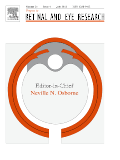
PROGRESS IN RETINAL AND EYE RESEARCH
Scope & Guideline
Transforming Insights into Eye Health
Introduction
Aims and Scopes
- Retinal Imaging and Diagnostics:
The journal emphasizes the significance of advanced imaging techniques, such as optical coherence tomography (OCT) and angiography, in diagnosing and managing retinal diseases, enhancing understanding of disease mechanisms. - Genetic and Molecular Mechanisms:
A core focus is on the genetic underpinnings of ocular diseases, exploring molecular pathways, gene therapy approaches, and inherited conditions that affect vision. - Therapeutic Innovations:
The journal highlights innovative treatment strategies, including novel pharmacological therapies, cell-based therapies, and gene editing techniques like CRISPR, aimed at restoring vision and managing ocular diseases. - Neurodegenerative Disease Links:
Research connecting retinal diseases with systemic neurodegenerative conditions, such as Alzheimer's disease, is a growing area, emphasizing the need for integrated approaches to ocular health. - Inflammation and Immune Response:
The role of inflammation in ocular diseases is a significant theme, with articles addressing both the pathophysiological mechanisms and potential therapeutic interventions to modulate immune responses. - Artificial Intelligence and Technology Integration:
The journal explores the integration of artificial intelligence in ophthalmology, particularly in diagnostics and treatment monitoring, showcasing how technology is transforming clinical practices.
Trending and Emerging
- AI and Machine Learning Applications:
The integration of artificial intelligence in diagnosing and managing retinal diseases is rapidly increasing, showcasing the potential for improved patient outcomes through technology-driven approaches. - Cell and Gene Therapy:
There is a growing interest in cell-based therapies and gene editing technologies as viable treatment options for inherited retinal diseases, reflecting advancements in translational research. - Impact of Systemic Diseases on Ocular Health:
Recent studies are increasingly linking systemic health issues, such as diabetes and COVID-19, to ocular manifestations, highlighting the need for a holistic understanding of patient health. - Microbiome Research:
Emerging research on the role of the gut microbiome in ocular health suggests a novel area of inquiry that may influence future treatments and understanding of ocular diseases. - Mechanobiology in Ocular Health:
The exploration of mechanobiology, particularly in relation to corneal and retinal health, is becoming a focal point, emphasizing the importance of mechanical factors in ocular conditions.
Declining or Waning
- Traditional Surgical Techniques:
There has been a noticeable decline in articles focusing on traditional surgical methods for ocular diseases, as the field shifts towards less invasive and more innovative techniques. - Basic Science Studies:
Papers that focus solely on basic science without direct clinical implications are becoming less common, as the journal increasingly prioritizes translational research that impacts clinical practice. - General Ophthalmology Topics:
Research that broadly addresses general ophthalmology without a specific focus on retinal or corneal diseases appears to be waning, as the journal hones in on more specialized content.
Similar Journals
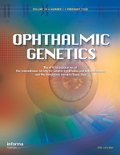
OPHTHALMIC GENETICS
Illuminating the Genetic Pathways of Eye DisordersOPHTHALMIC GENETICS is a distinguished journal published by TAYLOR & FRANCIS INC, specializing in the intersection of genetics and ophthalmology. Established in 1981, the journal has become a vital resource for researchers, clinicians, and students interested in the genetic aspects of eye diseases and disorders. Despite not being an Open Access journal, it maintains a commendable impact within the academic community, as reflected by its Q3 ranking in clinical genetics and Q2 rankings in both ophthalmology and pediatrics in 2023. With a robust focus on clinical applications, OPHTHALMIC GENETICS aims to provide a platform for innovative research and insights that drive advancements in patient care and understanding of genetic conditions affecting vision. The journal's international readership is supported by its timely publication of articles that bridge the gap between genetic research and practical ophthalmological applications.
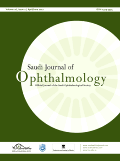
Saudi Journal of Ophthalmology
Empowering Practitioners: Elevating Standards in OphthalmologySaudi Journal of Ophthalmology, published by Wolters Kluwer Medknow Publications, stands as a crucial platform for the dissemination of innovative research and clinical practices in the field of ophthalmology. Since its inception in 2009, this journal has effectively contributed to the growing body of knowledge with a focus on addressing the diverse visual health challenges faced globally. With an ISSN of 1319-4534 and a E-ISSN of 2542-6680, the journal is indexed in Scopus, where it ranks in the Q3 category of ophthalmology, reflecting its commitment to quality research despite the competitive landscape. Situated in India, it provides a unique regional perspective while facilitating global discourse among researchers, practitioners, and students in ophthalmological sciences. Although it currently does not operate as an open-access journal, the Saudi Journal of Ophthalmology is essential for those aiming to expand their understanding of advancements in eye care, making it a valuable resource for professionals dedicated to enhancing patient outcomes through informed research and clinical practice.
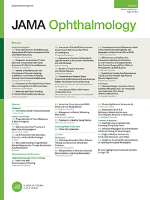
JAMA Ophthalmology
Pioneering Insights in OphthalmologyJAMA Ophthalmology, the premier journal in the field of ophthalmology, is published by the esteemed American Medical Association. Renowned for its rigorous peer-review process and commitment to advancing eye health research, JAMA Ophthalmology holds a prestigious position in the scientific community, boasting an impressive impact factor and ranking as Q1 in the category of Ophthalmology. With a Scopus rank of #3 out of 137 in its field and a remarkable 98th percentile, the journal serves as an invaluable resource for researchers, healthcare professionals, and students dedicated to the ophthalmic sciences. Readers can explore a wealth of cutting-edge findings, clinical studies, and review articles that not only contribute to the sustainable advancement of ophthalmic knowledge but also foster innovative approaches in patient care. As we converge into 2024, the journal continues to embrace open access principles, ensuring that groundbreaking research is readily available to a global audience, enhancing collaborative efforts and furthering the development of the ophthalmology discipline.

RETINA-THE JOURNAL OF RETINAL AND VITREOUS DISEASES
Unveiling Breakthroughs in Retinal ScienceRETINA - THE JOURNAL OF RETINAL AND VITREOUS DISEASES is a premier peer-reviewed journal dedicated to advancing the knowledge and practice of retinal and vitreous disorders. Published by LIPPINCOTT WILLIAMS & WILKINS, this esteemed journal boasts a significant impact factor, affirming its standing in the academic community. With a long history of publication since 1981, its scope covers cutting-edge research and innovations aimed at improving patient outcomes in ophthalmology. As evidenced by its recent categorization in the Q1 quartile for both Medicine (miscellaneous) and Ophthalmology in 2023, the journal ranks impressively, placing it in the 84th percentile among its peers. Researchers, clinicians, and students will find valuable insights and evidence-based articles that contribute to the ever-evolving landscape of retinal health. RETINA remains committed to fostering an environment for scholarly dialogue and dissemination of knowledge, ensuring its readers are at the forefront of advancements in their field.

Journal of VitreoRetinal Diseases
Exploring breakthroughs in retinal disease research.Journal of VitreoRetinal Diseases is a leading publication in the field of ophthalmology, specifically focusing on the complex landscape of vitreo-retinal conditions. Released by SAGE Publications Inc, this journal plays a crucial role in advancing the understanding and treatment of retinal diseases through high-quality, peer-reviewed research. With an ISSN of 2474-1264 and an E-ISSN of 2474-1272, the journal has gained recognition since its inception in 2017, currently ranking in the Q3 category of ophthalmology based on its Scopus metrics. Positioned within the 31st percentile among its peers, the journal provides a platform for the dissemination of innovative findings and clinical practices. Although it operates under a traditional access model, the significance of its contributions is profound, making it an essential resource for researchers, healthcare professionals, and students dedicated to improving patient outcomes in retinal health.
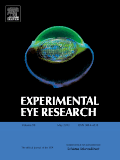
EXPERIMENTAL EYE RESEARCH
Pioneering Insights into Eye Function and DisordersEXPERIMENTAL EYE RESEARCH, published by Academic Press Ltd - Elsevier Science Ltd, is a preeminent journal dedicated to advancing the fields of ophthalmology and neuroscience. With a history of insightful publications dating back to 1961, this journal serves as a critical platform for researchers, professionals, and students interested in the cellular and molecular mechanisms underlying visual processes. The journal boasts impressive rankings, including being placed in the top quartile (Q1) of both the Ophthalmology and Sensory Systems categories, and is recognized in the 2nd quartile (Q2) for Cellular and Molecular Neuroscience. With an impact factor reflecting its significant contribution to the field, EXPERIMENTAL EYE RESEARCH is a valuable resource that promotes the exchange of innovative research and ideas essential for understanding the complexities of eye function and vision-related disorders. Researchers looking to publish their findings or stay abreast of the latest studies will find this journal a vital component of their academic toolkit.
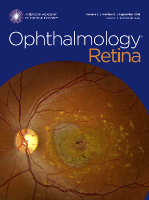
Ophthalmology Retina
Connecting thought leaders in retinal innovation.Ophthalmology Retina is a premier academic journal dedicated to advancing the field of retinal research and clinical practice. Published by Elsevier Inc, this esteemed journal is instrumental for professionals and researchers focusing on the rapidly evolving domain of ophthalmology. Being ranked in the Q1 category for Ophthalmology and achieving an impressive ranking of 12 out of 137 in Scopus, it holds a significant place in the academic community, underscoring its quality and impact with a remarkable 91st percentile ranking. Covering an extensive range of topics from basic science to innovative clinical applications, the journal aims to bridge the gap between research and practice, offering invaluable insights to enhance patient care. The journal is dedicated to publishing high-quality research and reviews, fostering a forum for discussion and collaboration among thought leaders in the field. With its commitment to excellence and relevance, Ophthalmology Retina is a vital resource for anyone seeking to stay at the forefront of retinal studies.

DOCUMENTA OPHTHALMOLOGICA
Fostering Innovation: Unveiling the Science Behind SightDOCUMENTA OPHTHALMOLOGICA is a prestigious journal published by SPRINGER, dedicated to advancing the field of ophthalmology since its inception in 1938. With a robust ISSN of 0012-4486 and an E-ISSN of 1573-2622, the journal has consistently delivered high-quality research, meriting a Q2 classification in Ophthalmology and a Q3 classification in both Physiology and Sensory Systems as of 2023. Located in the Netherlands at VAN GODEWIJCKSTRAAT 30, 3311 GZ DORDRECHT, DOCUMENTA OPHTHALMOLOGICA aims to publish rigorous studies, reviews, and innovations that bridge clinical practice and research. Although it does not currently offer Open Access options, the journal remains vital for researchers, professionals, and students seeking to stay abreast of developments in visual sciences and contribute to foundational knowledge in these domains.

Journal of the Korean Ophthalmological Society
Pioneering Research for Better Eye HealthThe Journal of the Korean Ophthalmological Society, with ISSN 0378-6471 and E-ISSN 2092-9374, is a pivotal resource in the field of ophthalmology, published by the esteemed Korean Ophthalmological Society. Based in South Korea, this journal is committed to advancing knowledge in ophthalmology through the dissemination of research that spans both clinical and experimental studies. Despite its current Q4 ranking in the 2023 Ophthalmology category, it serves as a crucial platform for emerging scholars, practitioners, and students seeking to contribute to and learn from the latest developments in eye care. While the journal does not currently offer open access, it is dedicated to fostering scientific dialogue and innovation within the community. With convergence years from 2018 to 2024, the journal's focus on contemporary issues in ophthalmology positions it as a relevant and timely source of information, critical for those engaged in this dynamic field. For further inquiries, the journal can be contacted at their address in Seoul, South Korea: SKY 1004 BLDG 701, 50-1 Jungnim-ro, Jung-gu, 04508.

Asia-Pacific Journal of Ophthalmology
Illuminating the future of ophthalmology in the Asia-Pacific.Asia-Pacific Journal of Ophthalmology is a distinguished open access journal published by the Asia-Pacific Academy of Ophthalmology (APAO), specializing in the latest advancements and research in ophthalmology. Since its inception in 2013, this journal has established itself as a vital platform for disseminating innovative findings and clinical practices across the Asia-Pacific region and beyond. With an impressive Scopus ranking of #10 out of 137 in the field of Medicine (Ophthalmology), placing it in the 93rd percentile, it garners significant attention and respect within the academic community. Currently holding a Q1 categorization in both Medicine (miscellaneous) and Ophthalmology, the journal embraces a broad scope that encompasses clinical studies, experimental research, and reviews aimed at enhancing the understanding and management of eye health. Its open access model since 2019 ensures that all published works are freely accessible, promoting greater collaboration and knowledge sharing among researchers, clinicians, and students. Situated in the Netherlands with a prominent address in Hong Kong, the journal serves as an essential resource for anyone dedicated to the field of ophthalmology.